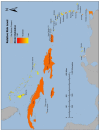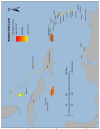Risk Modeling of Bat Rabies in the Caribbean Islands
- PMID: 32121504
- PMCID: PMC7157685
- DOI: 10.3390/tropicalmed5010035
Risk Modeling of Bat Rabies in the Caribbean Islands
Abstract
Rabies surveillance and control measures vary significantly between Caribbean islands. The Centers for Disease Control and Prevention currently recommends certain groups of U.S. travelers to any Caribbean island receive pre-exposure rabies immunization. However, most islands self-declare as "rabies free", and have never publicly released data to support rabies-free claims. We used the Analytic Hierarchy Process to create pairwise comparison values among five risk factors determined by subject matter experts. Risk factor weights were calculated and used in a geospatial analysis to calculate a risk value for each island nation (higher values indicate higher risk). Risk values ranged from 8.73 (Trinidad) to 1.57 (The Bahamas, Turks and Caicos Islands). All four countries that have documented occurrences of laboratory confirmed rabid bats were ranked highest (Trinidad and Tobago, Grenada, Cuba, Dominican Republic), as well as Haiti. The top five highest risk countries that currently have no reports of bat rabies include St. Vincent and the Grenadines, Jamaica, Puerto Rico, the Cayman Islands, and Dominica. This study reviews the inter-island movement potential of bats, designates areas of high risk for bat-associated rabies within the Caribbean islands, and demonstrates a need for further surveillance efforts in bat populations within islands that self-declare as rabies free.
Keywords: Latin America; chiroptera; dispersal; lyssavirus; risk mapping; surveillance; zoonoses.
Conflict of interest statement
The authors declare no conflict of interest.
Figures




Similar articles
-
Mongoose rabies in the Caribbean.Ann N Y Acad Sci. 1992 Jun 16;653:356-66. doi: 10.1111/j.1749-6632.1992.tb19662.x. Ann N Y Acad Sci. 1992. PMID: 1626884 Review.
-
Attaining higher coverage: obstacles to overcome. English-speaking Caribbean and Suriname.EPI Newsl. 1984 Dec;6(6):1-2. EPI Newsl. 1984. PMID: 12267938
-
Cholera in Haiti and other Caribbean regions, 19th century.Emerg Infect Dis. 2011 Nov;17(11):2130-5. doi: 10.3201/eid1711.110958. Emerg Infect Dis. 2011. PMID: 22099117 Free PMC article.
-
The Serological Prevalence of Rabies Virus-Neutralizing Antibodies in the Bat Population on the Caribbean Island of Trinidad.Viruses. 2020 Feb 5;12(2):178. doi: 10.3390/v12020178. Viruses. 2020. PMID: 32033370 Free PMC article.
-
Rabies surveillance in the United States during 2001.J Am Vet Med Assoc. 2002 Dec 15;221(12):1690-701. doi: 10.2460/javma.2002.221.1690. J Am Vet Med Assoc. 2002. PMID: 12494966 Review.
Cited by
-
Virulent Brucella nosferati infecting Desmodus rotundus has emerging potential due to the broad foraging range of its bat host for humans and wild and domestic animals.mSphere. 2023 Aug 24;8(4):e0006123. doi: 10.1128/msphere.00061-23. Epub 2023 Jul 5. mSphere. 2023. PMID: 37404031 Free PMC article.
-
Rabies in Costa Rica - Next Steps Towards Controlling Bat-Borne Rabies After its Elimination in Dogs.Yale J Biol Med. 2021 Jun 30;94(2):311-329. eCollection 2021 Jun. Yale J Biol Med. 2021. PMID: 34211351 Free PMC article. Review.
-
Determination of freedom-from-rabies for small Indian mongoose populations in the United States Virgin Islands, 2019-2020.PLoS Negl Trop Dis. 2021 Jul 15;15(7):e0009536. doi: 10.1371/journal.pntd.0009536. eCollection 2021 Jul. PLoS Negl Trop Dis. 2021. PMID: 34264951 Free PMC article.
-
Tick-borne viruses and their risk to public health in the Caribbean: Spotlight on bats as reservoirs in Cuba.Heliyon. 2024 Feb 9;10(4):e26118. doi: 10.1016/j.heliyon.2024.e26118. eCollection 2024 Feb 29. Heliyon. 2024. PMID: 38375245 Free PMC article. Review.
-
The Rabies Concert: Rising towards the Last Waltz?Trop Med Infect Dis. 2021 Jul 8;6(3):124. doi: 10.3390/tropicalmed6030124. Trop Med Infect Dis. 2021. PMID: 34287388 Free PMC article.
References
Grants and funding
LinkOut - more resources
Full Text Sources

